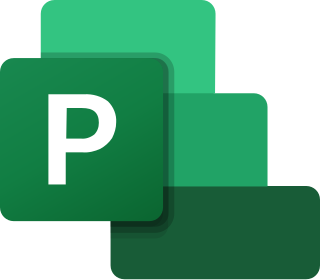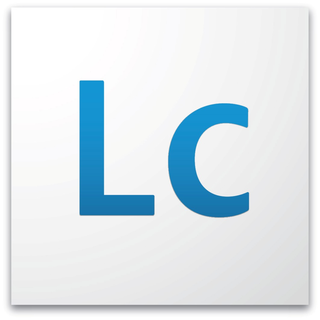
Microsoft Excel is a spreadsheet editor developed by Microsoft for Windows, macOS, Android, iOS and iPadOS. It features calculation or computation capabilities, graphing tools, pivot tables, and a macro programming language called Visual Basic for Applications (VBA). Excel forms part of the Microsoft 365 suite of software.

Microsoft Office, or simply Office, is a family of client software, server software, and services developed by Microsoft. It was first announced by Bill Gates on August 1, 1988, at COMDEX in Las Vegas. Initially a marketing term for an office suite, the first version of Office contained Microsoft Word, Microsoft Excel, and Microsoft PowerPoint. Over the years, Office applications have grown substantially closer with shared features such as a common spell checker, Object Linking and Embedding data integration and Visual Basic for Applications scripting language. Microsoft also positions Office as a development platform for line-of-business software under the Office Business Applications brand.

Microsoft Access is a database management system (DBMS) from Microsoft that combines the relational Access Database Engine (ACE) with a graphical user interface and software-development tools. It is a member of the Microsoft 365 suite of applications, included in the Professional and higher editions or sold separately.

Extensible Messaging and Presence Protocol is an open communication protocol designed for instant messaging (IM), presence information, and contact list maintenance. Based on XML, it enables the near-real-time exchange of structured data between two or more network entities. Designed to be extensible, the protocol offers a multitude of applications beyond traditional IM in the broader realm of message-oriented middleware, including signalling for VoIP, video, file transfer, gaming and other uses.

Microsoft Project is project management software product, developed and sold by Microsoft. It is designed to assist a project manager in developing a schedule, assigning resources to tasks, tracking progress, managing the budget, and analyzing workloads.

Microsoft Office 2003 is an office suite developed and distributed by Microsoft for its Windows operating system. Office 2003 was released to manufacturing on August 19, 2003, and was later released to retail on October 21, 2003, exactly two years after the release of Windows XP. It was the successor to Office XP and the predecessor to Office 2007. The Mac OS X equivalent, Microsoft Office 2004 for Mac was released on May 11, 2004.
Windows Presentation Foundation (WPF) is a free and open-source graphical subsystem originally developed by Microsoft for rendering user interfaces in Windows-based applications. WPF, previously known as "Avalon", was initially released as part of .NET Framework 3.0 in 2006. WPF uses DirectX and attempts to provide a consistent programming model for building applications. It separates the user interface from business logic, and resembles similar XML-oriented object models, such as those implemented in XUL and SVG.

Outlook on the web is a personal information manager web app from Microsoft. It is a web-based version of Microsoft Outlook, and is included in Exchange Server and Exchange Online

Microsoft Office 2007 is an office suite for Windows, developed and published by Microsoft. It was officially revealed on March 9, 2006 and was the 12th version of Microsoft Office. It was released to manufacturing on November 3, 2006; it was subsequently made available to volume license customers on November 30, 2006, and later to retail on January 30, 2007, shortly after the completion of Windows Vista. The ninth major release of Office for Windows, Office 2007 was preceded by Office 2003 and succeeded by Office 2010. The Mac OS X equivalent, Microsoft Office 2008 for Mac, was released on January 15, 2008.
Active Directory Rights Management Services is a server software for information rights management shipped with Windows Server. It uses encryption and a form of selective functionality denial for limiting access to documents such as corporate e-mails, Microsoft Word documents, and web pages, and the operations authorized users can perform on them. Companies can use this technology to encrypt information stored in such document formats, and through policies embedded in the documents, prevent the protected content from being decrypted except by specified people or groups, in certain environments, under certain conditions, and for certain periods of time. Specific operations like printing, copying, editing, forwarding, and deleting can be allowed or disallowed by content authors for individual pieces of content, and RMS administrators can deploy RMS templates that group these rights together into predefined rights that can be applied en masse.

Adobe LiveCycle Enterprise Suite (ES4) is a service-oriented architecture Java EE server software product from Adobe Systems used to build applications that automate a broad range of business processes for enterprises and government agencies. LiveCycle ES4 is an enterprise document and form platform that helps you capture and process information, deliver personalized communications, and protect and track sensitive information. It is used for purposes such as account opening, services, and benefits enrollment, correspondence management, requests for proposal processes, and other manual-based workflows. LiveCycle ES4 incorporates new features with a particular focus on mobile devices. LiveCycle applications also function in both online and offline environments. These capabilities are enabled through the use of Adobe Reader, HTML/PhoneGap, and Flash Player clients to reach desktop computers and mobile devices.
Oracle XML Publisher (XMLP) is Oracle Corporation's latest reporting technology. It was originally developed to solve the reporting problems faced by Oracle Applications. Osama Elkady from the Applications Technology Group and Tim Dexter from the Financials Group were the main drivers for the product. It was first released with Oracle E-Business Suite 11.5.10 in 2003. Since then it has been integrated into most of Oracle Products including JD Edwards EnterpriseOne application 8.12 and PeopleSoft Enterprise 9, and as a standalone version, XML Publisher Enterprise with no dependency on Oracle Applications. When XML Publisher became part of the Oracle BI Enterprise Edition Suite it was re-branded as Oracle BI Publisher.
The Microsoft Office XML formats are XML-based document formats introduced in versions of Microsoft Office prior to Office 2007. Microsoft Office XP introduced a new XML format for storing Excel spreadsheets and Office 2003 added an XML-based format for Word documents.
Azure DevOps Server, formerly known as Team Foundation Server (TFS) and Visual Studio Team System (VSTS), is a Microsoft product that provides version control, reporting, requirements management, project management, automated builds, testing and release management capabilities. It covers the entire application lifecycle and enables DevOps capabilities. Azure DevOps can be used as a back-end to numerous integrated development environments (IDEs) but is tailored for Microsoft Visual Studio and Eclipse on all platforms.

SharePoint is a web-based collaborative platform that integrates natively with Microsoft 365. Launched in 2001, SharePoint is primarily sold as a document management and storage system, although it is also used for sharing information through an intranet, implementing internal applications, and for implementing business processes.
Intrexx is a cross-platform integrated development environment for the creation and operation of multilingual web-based applications, intranets, social intranets, enterprise portals and customer portals (extranets) as well as Industry 4.0 solutions as of 2018. A portal is created based on the drag and drop principle. Intrexx is a low-code development platform. Most applications can be created via drag & drop but manual coding can be added where necessary.
Microsoft Power BI is an interactive data visualization software product developed by Microsoft with a primary focus on business intelligence. It is part of the Microsoft Power Platform. Power BI is a collection of software services, apps, and connectors that work together to turn various sources of data into static and interactive data visualizations. Data may be input by reading directly from a database, webpage, PDF, or structured files such as spreadsheets, CSV, XML, JSON, XLSX, and SharePoint.
ASP.NET Web Forms is a web application framework and one of several programming models supported by the Microsoft ASP.NET technology. Web Forms applications can be written in any programming language which supports the Common Language Runtime, such as C# or Visual Basic. The main building blocks of Web Forms pages are server controls, which are reusable components responsible for rendering HTML markup and responding to events. A technique called view state is used to persist the state of server controls between normally stateless HTTP requests.

Collabora Online is an open source online office suite built on LibreOffice Technology, enabling web-based collaborative real-time editing of word processing documents, spreadsheets, presentations, and vector graphics. Optional apps are available for desktops, laptops, tablets, smartphones, and Chromebooks.












